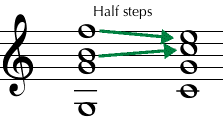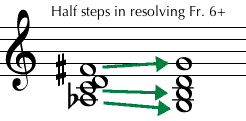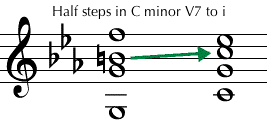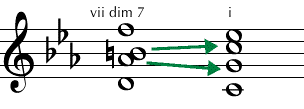Answer: What I like about this question is that it has no practical relevance; it stems from pure curiosity. And like many explorations founded on curiosity, there's stuff here to be discovered. I've never really thought about this one myself, but I can explore it along with you.
The resolution by movement of a half-step is an important factor in driving harmonic changes. In the familiar V7 - I of a major key we are used to hearing a diminished 5th or augmented 4th resolve in such a way that two of its pitches move by half step to notes of the following chord:

That kind of movement is also what makes the augmented 6th chords work: the dissonant 6+ expands by half steps at each end to make an octave. The normal resolution of the "French" aug 6 chord contains three half-step moves:

In short, movement by half-step adds to the logic of a harmonic change, and if it's a case of a dissonant interval resolving by half step the feeling is even stronger.
When playing tonal music the minor scale usually appears with its 7th degree raised, to allow a half-step leading tone that can resolve to the tonic. With that 7th raised one can play a V7 chord in minor, just as in major, allowing the strong V7-i chord change. But the V7-i in minor is not quite as strong as V7-I in major, because the 7 in the V7 has to move down by a whole step rather than a half step:

How can the minor key make up for this failing and regain its self-esteem? It can turn to its own advantage something not found in the major scale: the minor key has a half step above its fifth, which means that without changing any notes of the harmonic minor, a diminished seventh chord on the last note of the scale has two half-step resolutions, restoring a lot of that voice-leading power.

The diminished triad built on vii is just a substitute for the V7; it's the same notes as V7, but lacking the root. Adding a diminished seventh to that dim 7 triad makes it work even better, but in a major key one would have to alter another chord tone to get a dim 7. In harmonic minor it's right there, ready to use. So it makes sense in minor that the vii dim 7 chord is a useful substitute for the V7 - especially in a scale practice book whose goal is to teach you the notes of the harmonic minor without introducing pitches outside the scale. They could have given you an ordinary V7 - i, but this has more color and displays more of the nature of the harmonic minor.

